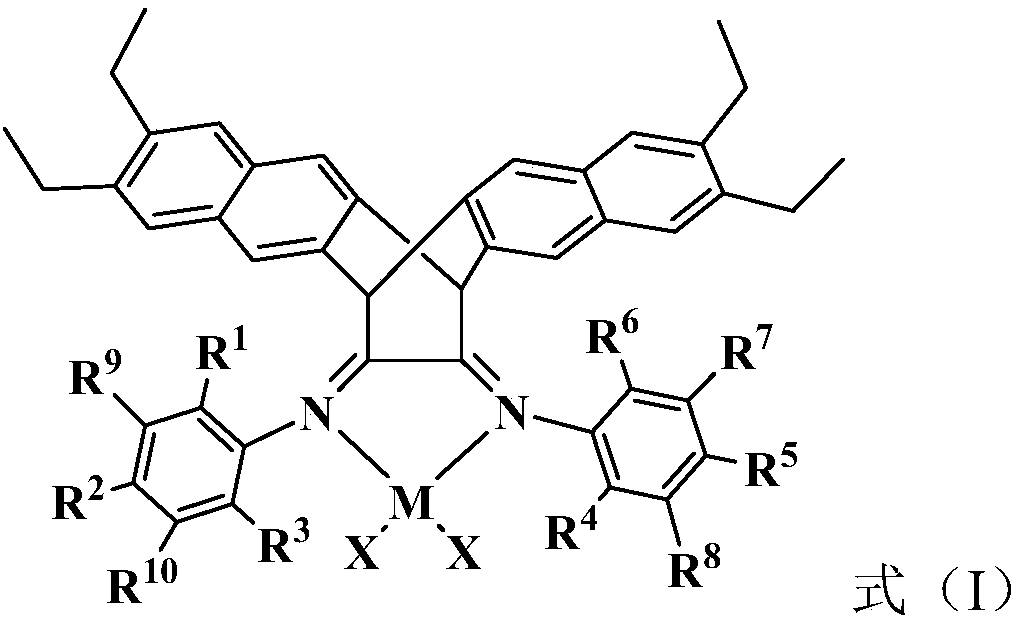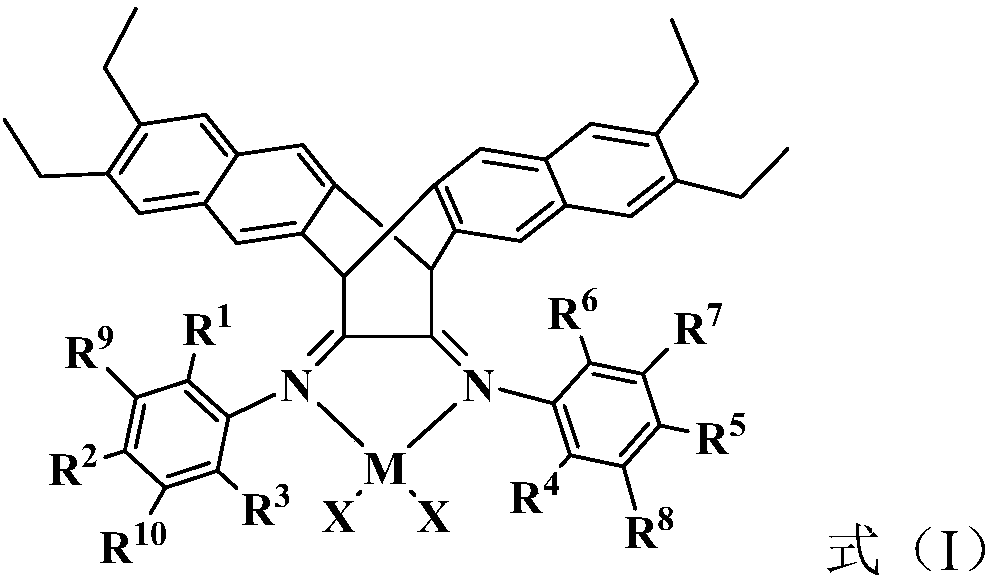Copolymerization method of ethylene and alkenyl-terminated silane/siloxane
A technology of terminal alkenyl silane and siloxane, which is applied in the field of copolymerization of ethylene and terminal alkenyl silane/siloxane, can solve the problems of low polymerization activity, inability to carry out copolymerization reaction, low polymer molecular weight and low degree of branching, etc. , to achieve the effect of high polymerization activity and broad industrial application prospects
- Summary
- Abstract
- Description
- Claims
- Application Information
AI Technical Summary
Problems solved by technology
Method used
Image
Examples
Embodiment approach
[0026] According to a preferred embodiment of the present invention, the main catalyst is selected from at least one of the following complexes,
[0027] Complex 1: R 1 = R 3 = R 4 = R 6 = Me,R 2 = R 5 = H, X = Br;
[0028] Complex 2: R 1 = R 3 = R 4 = R 6 =Et,R 2 = R 5 = H, X = Br;
[0029] Complex 3: R 1 = R 3 = R 4 = R 6 =iPr, R 2 = R 5 = H, X = Br;
[0030] Complex 4: R 1 = R 2 = R 3 = R 4 = R 5 = R 6 =Me, X=Br;
[0031] Complex 5: R 1 = R 3 = R 4 = R 6 = Me,R 2 = R 5 =Br, X=Br;
[0032] Complex 6: R 1 = R 3 = R 4 = R 6 = Me,R 2 = R 5 = Et, X = Br;
[0033] Complex 7: R 1 = R 3 = R 4 = R 6 =Et,R 2 = R 5 =Me, X=Br;
[0034] Complex 8: R 1 = R 3 = R 4 = R 6 =Et,R 2 = R 5 =Br, X=Br;
[0035] Complex 9: R 1 = R 3 = R 4 = R 6 = F, R 2 = R 5= H, X = Br;
[0036] Complex 10: R 1 = R 3 = R 4 = R 6 = Cl, R 2 = R 5 = H, X = Br;
[0037] Complex 11: R 1 = R 3 = R 4 = R 6 =Br,R 2 = R 5 = H, X = Br;
[0038] Comp...
Embodiment 1
[0099] The 1L stainless steel polymerization kettle equipped with mechanical stirring was continuously dried at 130°C for 6hrs, vacuumized while hot and heated with N 2 Air replacement 3 times. Add 9.8 mg (10 μmol) of complex 3, then vacuumize and replace with ethylene three times; inject 500 mL of toluene, and then add 6.5 mL of methylaluminoxane (MAO) (1.53 mol / L toluene solution) to make Al / Ni=1000, 5mL of allyltrimethoxysilane (28.7mmol), at 70°C, maintain ethylene pressure of 10atm, and stir for 30min. Finally, it was neutralized with an ethanol solution acidified with 5 volume % hydrochloric acid to obtain a polymer. The polymerization activity and performance parameters of the polymer are shown in Table 1.
Embodiment 2
[0101] The 1L stainless steel polymerization kettle equipped with mechanical stirring was continuously dried at 130°C for 6hrs, vacuumized while hot and heated with N 2 gas replacement 3 times; add 9.8 mg (10 μmol) of complex 3, then vacuumize and replace with ethylene 3 times; inject 500 mL of toluene, then add 6.5 mL of methylaluminoxane (MAO) (1.53 mol / L toluene solution ), make Al / Ni=1000, 5mL allyltrimethoxysilane (28.7mmol), at 100°C, keep 10atm ethylene pressure, and stir for 30min. Finally, it was neutralized with an ethanol solution acidified with 5 volume % hydrochloric acid to obtain a polymer. The polymerization activity and performance parameters of the polymer are shown in Table 1.
PUM
 Login to View More
Login to View More Abstract
Description
Claims
Application Information
 Login to View More
Login to View More - R&D
- Intellectual Property
- Life Sciences
- Materials
- Tech Scout
- Unparalleled Data Quality
- Higher Quality Content
- 60% Fewer Hallucinations
Browse by: Latest US Patents, China's latest patents, Technical Efficacy Thesaurus, Application Domain, Technology Topic, Popular Technical Reports.
© 2025 PatSnap. All rights reserved.Legal|Privacy policy|Modern Slavery Act Transparency Statement|Sitemap|About US| Contact US: help@patsnap.com



